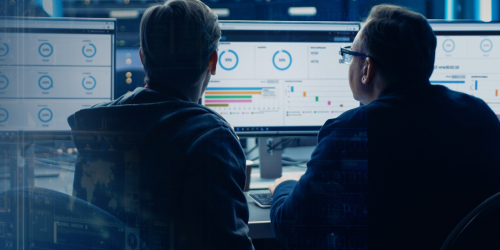
Industrial organizations around the world are under pressure. The price of electricity and fuel have skyrocketed in many regions, with some areas experiencing rate increases of 200-300% compared to a few years ago.
In Europe, these cost pressures are extreme. For energy-intensive sectors, astronomical prices are jeopardizing the viability of businesses.
The costs and risks to other resources are also rising. Regions are facing water stress caused in part by drought, changing weather patterns, and current water management practices. Raw material prices in some sectors have risen dramatically or become volatile while for others, availability of key materials poses an extreme threat.
Furthermore, the pressure to address industrial impact on the climate crisis is coming from all sides:
- Investors view sustainability as tactical risk management
- Consumers demand products that align with their values
- Legislators are mobilizing to mandate climate disclosures
These global pressures require industrial companies to rethink their value chains and explore new ways to optimize their facilities to improve their resource efficiency and effectiveness. Industrial companies are responding by setting ambitious targets with timelines between 2025 and 2050, which require meaningful and demonstrable progress year over year.
Two of the foremost challenges in addressing industrial organizations’ sustainability impact are:
- Access to high-quality data relevant to their sustainability goals
- Understanding of how to act upon the data
Fortunately, proven automation, historian, and analytics technology support this demand for data and drive the right actions to optimize utilities usage and provide significant energy savings.
Utilities Software for Automation and Analytics to Optimize Energy Savings
Utilities software for optimization can leverage existing HMI/SCADA, MES and historian technology in conjunction with modern, persona-based dashboards and industrial analytics. This innovation such as Proficy from GE Digital provides industrial companies with the ability to monitor, correlate, understand, and then optimize the resource consumption within each plant in their enterprise. By putting the right data in the hands of those who need it to make plant-floor decisions – supported through AI/ML-driven insights – industrial companies can continuously and effectively manage their resource usage at the point of consumption.
Companies can achieve energy savings of 10% or more within the first year, depending on their specific application. Furthermore, the software provides companies with the contextualized data that is needed to drive substantive progress toward their sustainability KPIs, such as the company’s Scope 1 and Scope 2 carbon footprints. Operational emissions and any other sustainability KPIs can be managed alongside cost, throughput, quality, or any other operational target.
As an example, a large automotive Tier 1 OEM recently achieved 18% energy savings on its heating. The company has used GE Digital’s Proficy software for its SCADA for many years. With a growing focus on energy optimization, the company looked to leverage their existing SCADA with new analytics and dashboard innovation to optimize the heating and cooling in its many energy-intensive production facilities.
In conjunction with its CIMPLICITY SCADA, the team used Proficy CSense industrial analytics and Proficy Operations Hub to optimize system setpoints based on outside air temperatures. Additionally, the CSense Troubleshooter identified a problem in the heating system control related to response to temperature setpoints as well as a problem with valves not closing correctly.

DEMOS & FREE TRIALS
Download our software & see how Proficy can help meet sustainability goals.
GET YOUR FREE TRIALS
Another example, one of the world’s largest glass container manufacturers improved quality, safety, and efficiency by adopting Proficy software for process visualization, supervisory control, and analysis. The company has helped protect the environment by significantly lowering energy needs and reducing furnace emissions by 80%. Optimizing production also reduced defects by 25%, downtime by 25%, and annual operating costs.
Lastly, a national library in Europe reduced energy consumption by 20-25% in four years with a Proficy software solution. The library can manage equipment on five remote sites including one with 225,000 I/O points to save energy while keeping its assets safe. The system reduces costs by efficiently maintaining the ambient conditions in more than 250 archival storerooms, helping to keep valuable documents in optimum condition. According to the deputy manager of technical facilities for the national library, “The changes we were able to make as a result of using the GE solution have had the greatest impact on our total budget.”

CASE STUDY
Explore how the National Library reduced energy consumption by 20-25%
DOWNLOAD ENERGY SAVINGS CASE STUDY
Correlating Usage to Operating Conditions
A utilities optimization solution such as Proficy connects to a company’s historical production data as well as context and event data, allowing for real-time monitoring of usage and correlation to key operating conditions, including product SKUs. Advanced multi-faceted analytics help to detect previously unrecognized patterns, waste, and opportunities for improvement, so companies can understand their utilities consumption comprehensively. The solution also provides recommendations for better performance by modeling usage and predicting where setpoints and process conditions could be changed to minimize consumption. These capabilities allow industrial companies to better visualize, report, and act on the sustainability and financial goals that will keep their business competitive.
Real-time utilities software optimization dashboards enable engineers and operators to continuously benchmark, explain, and improve utilities consumption at plants and facilities throughout the enterprise. Companies are empowered to:
- Benchmark: “Are we currently consuming too much on any meter?” Users can compare real-time actual usage against expected, normal, or targeted consumption for any meter and receive real-time alerts if current operating conditions are consuming more than the targeted or expected amounts for those circumstances.
- Explain: “Why are we using too much now?” Analytics running continuously in the background correlate each meter with other operational data to identify possible causes when consumption is greater than expected or targeted to help identify improvement opportunities – such as switching off equipment that doesn’t need to be running or adjusting machines or setpoints when possible
- Improve: “How can we improve consumption?” Engineers at any time can configure and deploy simple control rules or optimize using advanced control optimizers to switch equipment on/off, recommend or automatically change control setpoints to reduce consumption peaks, minimize costs, and eliminate wasted consumption such as unnecessary usage during non-production periods.
Managers, engineers, and operators can access the web-based solution dashboards from anywhere at any time on their mobile phone, tablet, or laptop and desktop browsers.
With the utilities optimization solution, companies can compare current performance to budgeted consumption amounts and improvement targets, prior best demonstrated performance, and expected consumption based on past performance for each monitored utility (water, fuel, electricity, derivate steam, compressed air, etc.). The utilities optimization software can provide the ability to drill into any plant/facility, line/machine, or individual utilities consumption meter across the enterprise – helping companies to achieve energy savings, address pressing sustainability concerns, and drive greater efficiency with automation and analytics.
Ben Whiteman
Product Manager – Circularity and Sustainability, GE Digital
